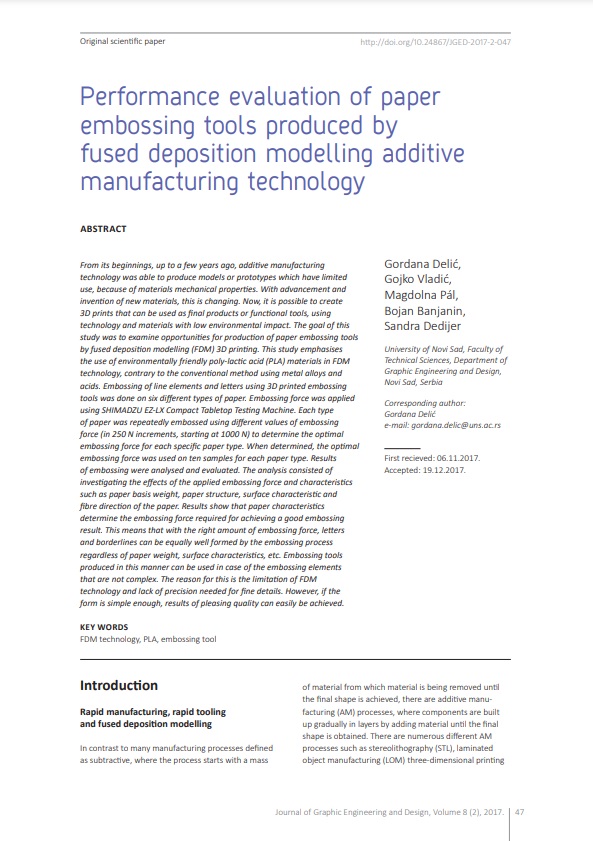Performance evaluation of paper embossing tools produced by fused deposition modelling additive manufacturing technology

Published 2017-12-01
abstract views: 293 // Full text article (PDF): 134
Keywords
- FDM technology,
- PLA,
- embossing tool
How to Cite
Copyright (c) 2017 © 2017 Authors. Published by the University of Novi Sad, Faculty of Technical Sciences, Department of Graphic Engineering and Design. This article is an open access article distributed under the terms and conditions of the Creative Commons Attribution license 3.0 Serbia.

This work is licensed under a Creative Commons Attribution 3.0 Unported License.
Abstract
-
From its beginnings, up to a few years ago, additive manufacturing technology was able to produce models or prototypes which have limited use, because of materials mechanical properties. With advancement and invention of new materials, this is changing. Now, it is possible to create 3D prints that can be used as final products or functional tools, using technology and materials with low environmental impact. The goal of this study was to examine opportunities for production of paper embossing tools by fused deposition modelling (FDM) 3D printing. This study emphasises the use of environmentally friendly poly-lactic acid (PLA) materials in FDM technology, contrary to the conventional method using metal alloys and acids. Embossing of line elements and letters using 3D printed embossing tools was done on six different types of paper. Embossing force was applied using SHIMADZU EZ-LX Compact Tabletop Testing Machine. Each type of paper was repeatedly embossed using different values of embossing force (in 250 N increments, starting at 1000 N) to determine the optimal embossing force for each specific paper type. When determined, the optimal embossing force was used on ten samples for each paper type. Results of embossing were analysed and evaluated. The analysis consisted of investigating the effects of the applied embossing force and characteristics such as paper basis weight, paper structure, surface characteristic and fibre direction of the paper. Results show that paper characteristics determine the embossing force required for achieving a good embossing result. This means that with the right amount of embossing force, letters and borderlines can be equally well formed by the embossing process regardless of paper weight, surface characteristics, etc. Embossing tools produced in this manner can be used in case of the embossing elements that are not complex. The reason for this is the limitation of FDM technology and lack of precision needed for fine details. However, if the form is simple enough, results of pleasing quality can easily be achieved.

